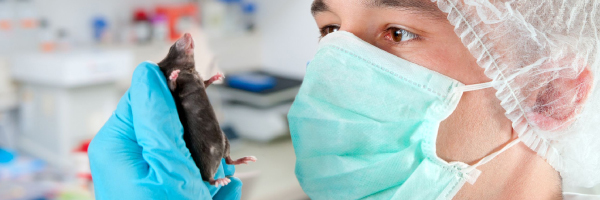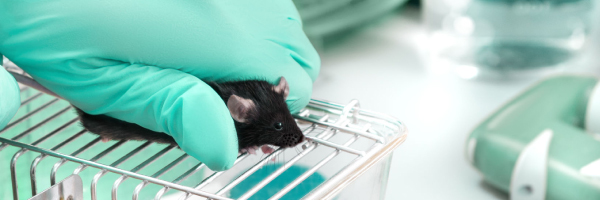The Necessity of Lab Animal Testing
Posted on March 31, 2017
Animal testing has long been the backbone of scientific research. It is a widely accepted practice for testing the safety and efficacy of new drugs before implementing on human. This has resulted in massive breakthroughs in medicine and treatments and substantial improvements in the quality of life for people in both the developed and developing world. As a result, the average global life expectancy has dramatically increased during the 20th century.
However, there are contentious debates regarding the ethical use and treatment of laboratory animals. Many groups, including The PETA and Cruelty Free International, perceive testing as inhumane, unregulated, and unnecessary. Many have also suggested that the suffering inflicted on animals cannot justify the possible scientific advancement.
Does that mean we should ban animal testing? According to a poll conducted by Pew Research Center, the general public is closely divided when comes to the use of animals in research. Some 47% favor the practice, while a nearly equal share (50%) opposes it. While there are valid concerns for animal rights, halting animal experimentation can significantly hinder scientific progress.
What is the best alternative for researchers in a world where animal testing is so maligned? Lets start by examining the reasons that public opinion has soured.
Opposition To Animal Testing
A majority of the concerns around animal testing comes from the compunctions the public has over the potential for animal abuse and cruelty. In an article by PETA, Animal Testing Is Bad Science, the group argues that “… Most experiments on animals are not relevant to human health, they do not contribute meaningfully to medical advances, and many are undertaken simply out of curiosity and do not even pretend to hold promise for curing illnesses.”
To exemplify their position, opponents have pointed out that the federal Animal Welfare Act does not offer protections against a large percentage of animals commonly used in experimentation, including mice, rats, and birds. By discriminating rights to these animals, it allows researchers free reign to perform potentially unethical procedures – a carte blanche with little to no consequences.
Opponents have also postulate that alternative testing methods are available and capable of replacing the utility of live animals. For example, studying human cell-based in vitro can allow researchers to perform experiments using only petri dishes and test tubes. It has also been used extensively for liver toxicity testing. It has been argued that computer modeling can also replicate the animal and human body. The first heart stimulation have fueled the development of other model organs, such as lungs and brains. Microdosing is the practice of giving an extremely low dose of the drugs in human subjects to define its pharmacokinetic profile.
To a large segment of the general public, these arguments are compelling. However, they ignore some basics about the efficacy and implementation of animal testing.
Why Animal Testing is Necessary
Firstly, it is hard to ignore the vital role animal testing has on medical advancement. The breakthrough in medicine and understanding of human health in the last few centuries alone have been astounding – with virtually every one due to contribution from animal research.
Human shares a strong genetic resemblance with certain animals: 98.8% with the chimpanzee and approximately 90% – 95% with mice. Moreover, many animals and human evolved from a common ancestor, such that our structures (lungs, heart, brain, etc.) remain anatomically similar to one another, providing automatic feedback of the human body.
Many crippling illnesses and disease have reached a resolution as a result of animal involvement. For example, antidepressant was first serendipitously discovered in the 1950s when tuberculosis experiments on rodents and nonhuman primates was found to effectively alter mood through these chemical messengers dubbed as ‘neurotransmitters’. It has since provided many insights on the causes of depression that is still relevant today. Animal testing has also led to new understandings in behavioral and cognitive functioning – Ivan Pavlov could not have developed and proven his theory on classical conditioning had he been without his dogs.
Animal testing has led to positive outcomes for animals as well. Vaccines for rabies, distemper, tetanus, and parvo were first tested on animals and continue to save their lives to this day.
It is important to also consider the consequences of bypassing basic animal testing. In 1937, a pharmaceutical manufacturer created Elixir Sulfanilamide, a liquid form of a popular drug called sulfanilamide mixed with diethyl glycol, a deadly form of poison that the head chemist, at the time, was not privy. Unfortunately, its consumption resulted in the death of 100 deaths in a little less than a month. Prior testing on animals may have prevented this tragedy.
Moreover, alternative testing methods are currently very limited in their abilities to fully replace the wide range that animal testing can provide. Cell cultures (in vitro), while a good candidate for organs in isolation, cannot possibly replicate the complexity of the living body, which involves the intricate and interrelated operation of many systems. In addition, computer modeling requires a precise understanding of the anatomy and physiology of the animal for accurate simulation – therefore requiring further testing of animals. In its current state, there are only specific instances in which alternative methods can replace animal testing.
For the most part, animal experimenters are aware of the ethical issues revolving around animal cruelty. It is widely acknowledged that animals have certain inalienable rights and it is the responsibility of the researcher to preserve those rights. The NIH have long established necessary readings, including The Guide For The Care And Use Of Laboratory Animals, in order to systemize and address the need for ethical treatments.
In addition, researchers are required to follow the set of principles known as “3Rs”. These are the following:
- Replace: Methods that avoid or replace the use of animals. Whenever possible, this means implementing alternative techniques such as cell culture, computer modeling, or microdosing in human.
- Reduce: Methods that minimizes the number of animals per experiment. This can include improving experimental techniques and sharing information and results to the science community to reduce the number of researchers performing the same experiments.
- Refine: Method that seeks to minimize the suffering, pain, distress or lasting harm experienced by the animal. This includes reducing invasive procedures and improving quality of life.
Conclusion
Animal testing still have a relevant place in the advancement of scientific research. But there are no doubt that the humane treatment of lab animals are of utmost priority. It is recommended that scientists implement all the necessary framework and tools for continual commitment to quality research. This includes adopting the 3Rs into practice by continuing to refine research methods and seek improvements where possible.
RapID Labs knows full well that researchers will choose the most humane option when it is available. That is why they designed RapID Tags to be just that. Such advances underscore the commitment to the ethical treatment of animals while noting the value that animal testing has to breakthrough scientific advancements.


